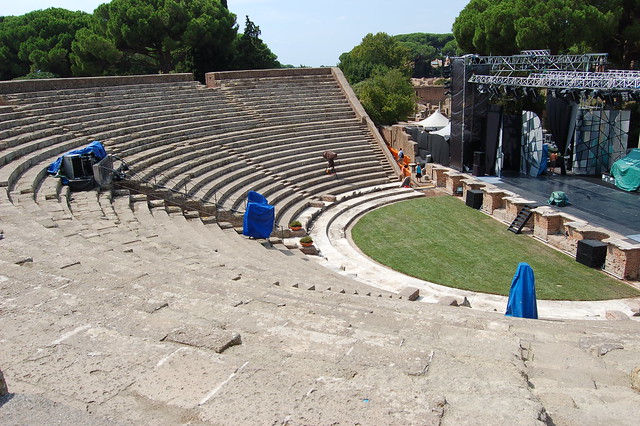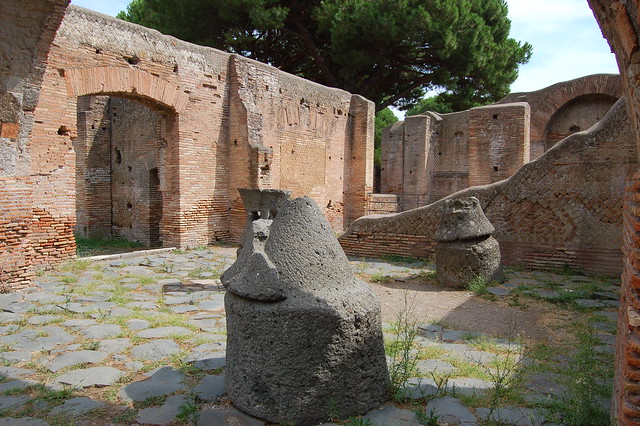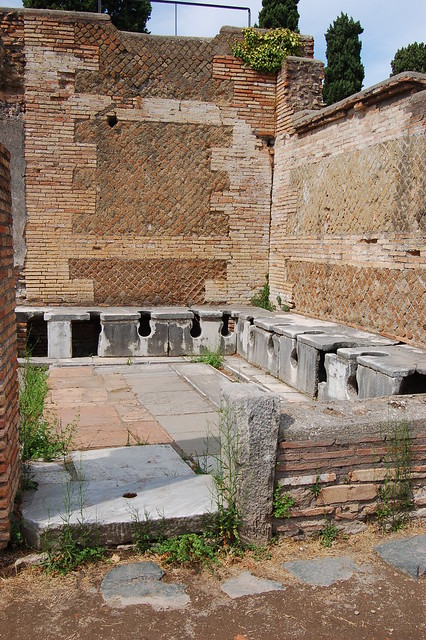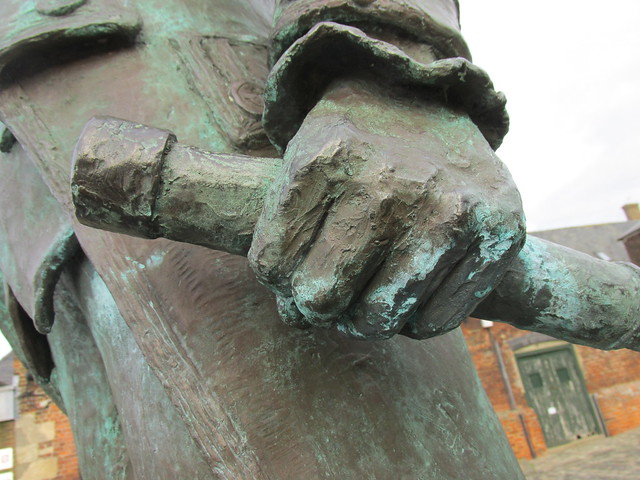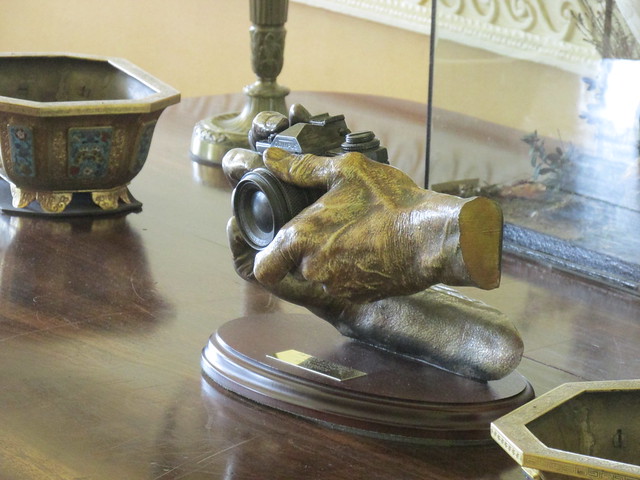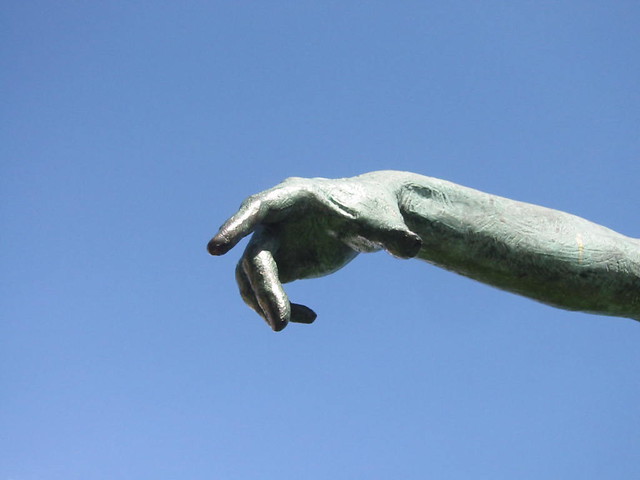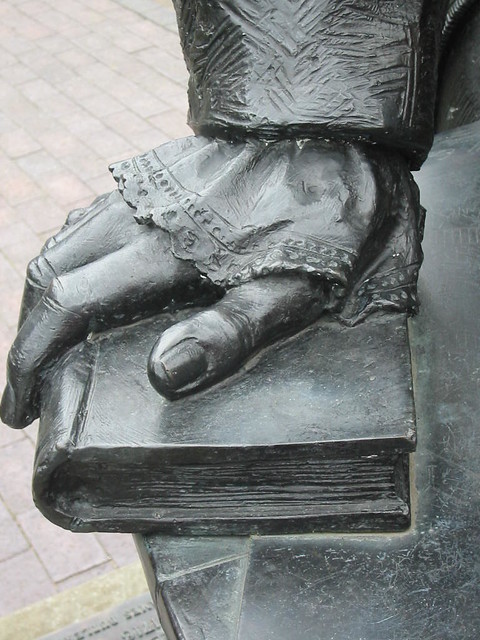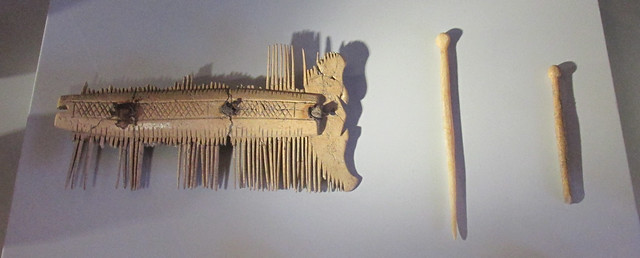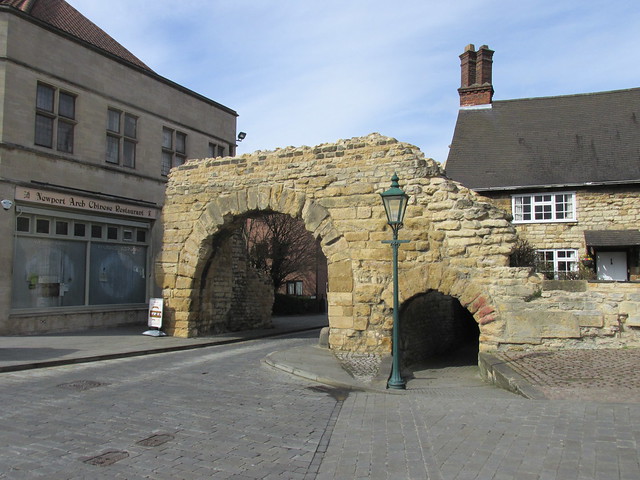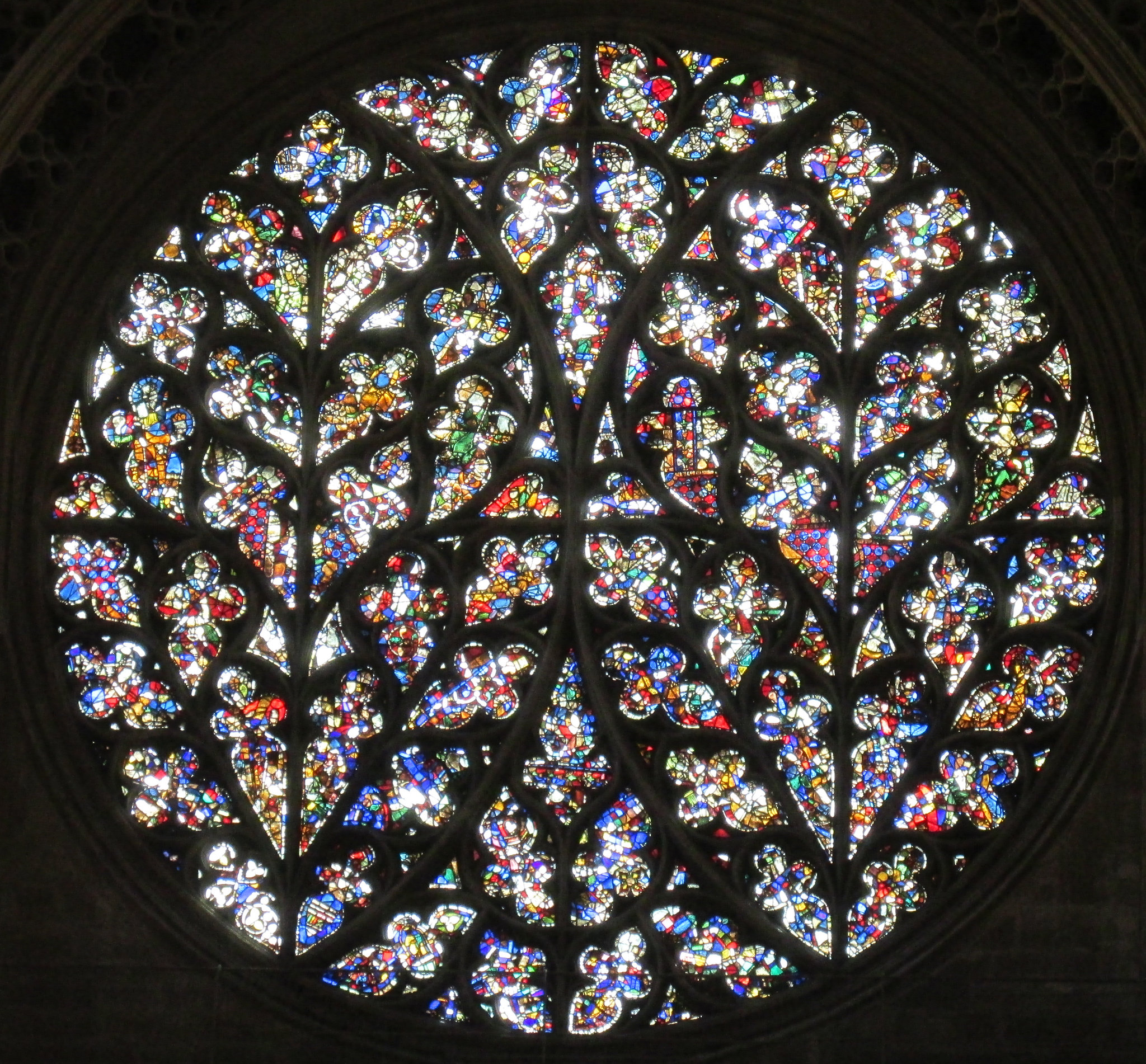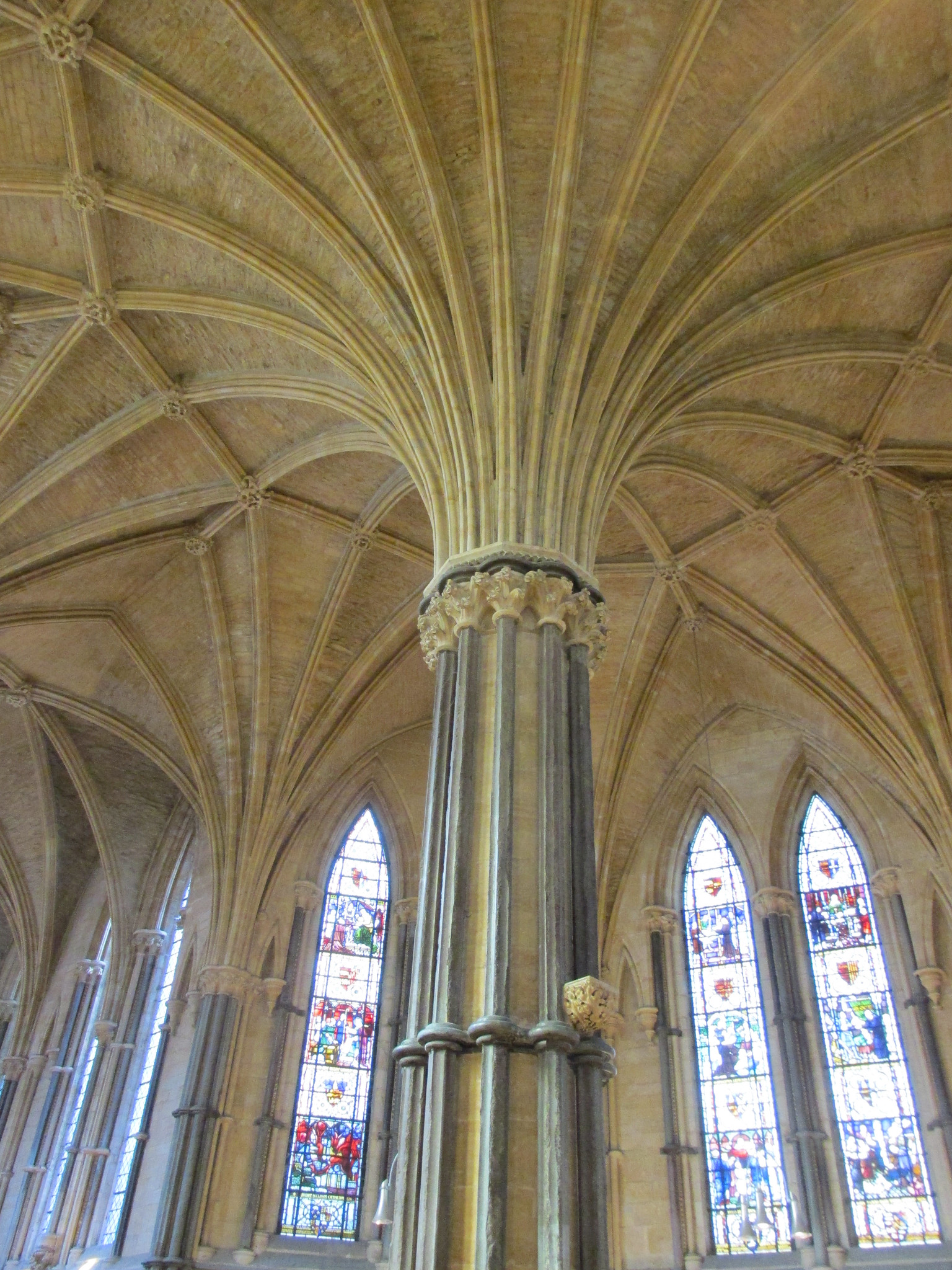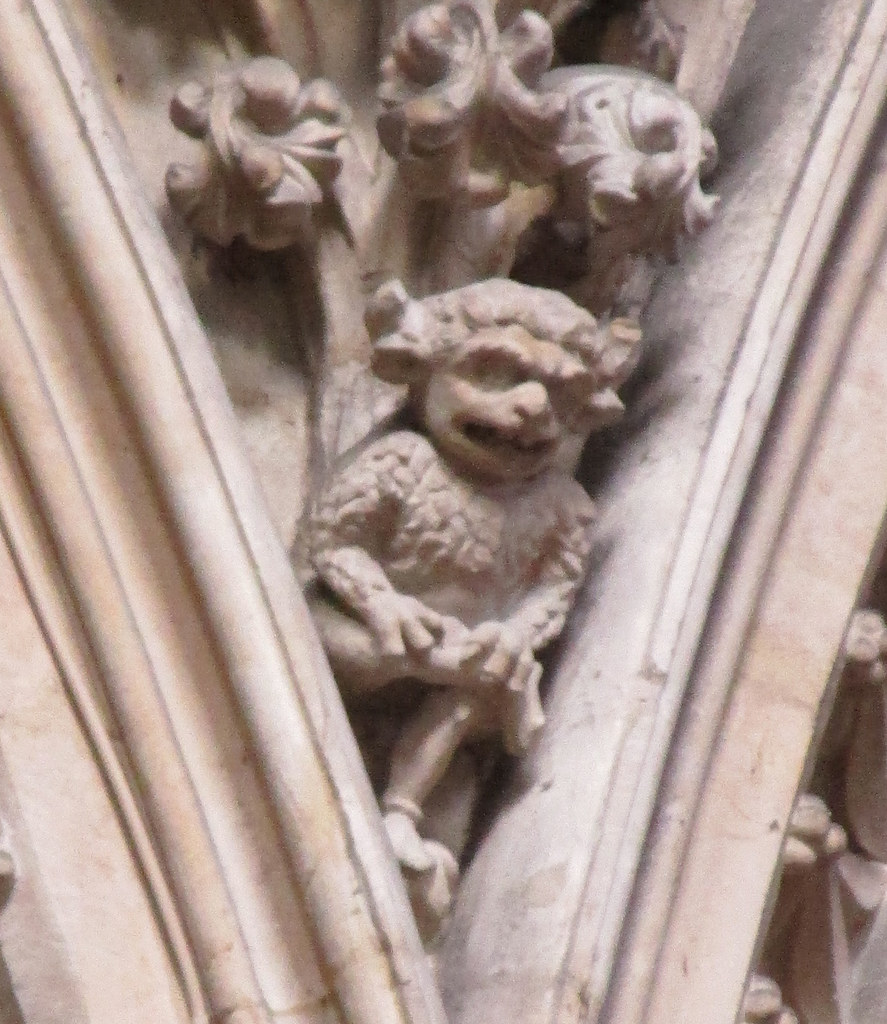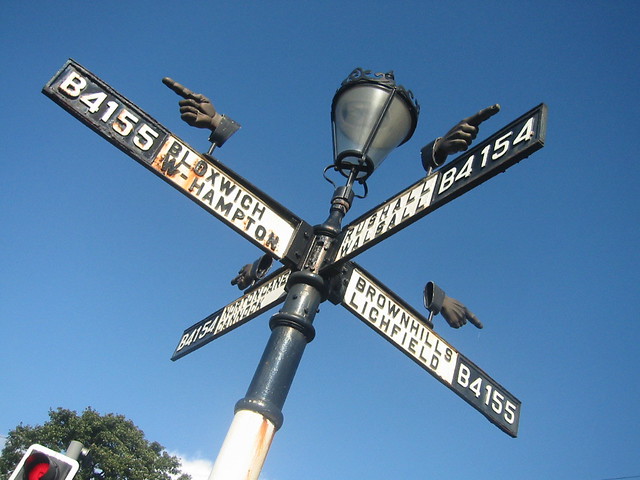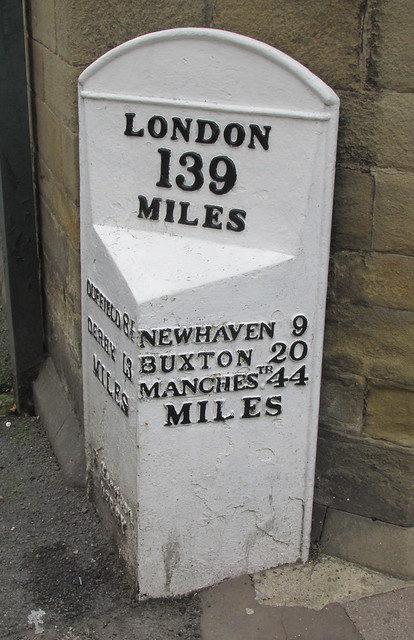It's Friday again, so we're off to meet Amy at Love Made My Home for her Five on Friday feature. You might think after my Lincoln trip a couple of weeks ago that you've seen all there is to see about the Romans, but no. Here's some examples of Romans in Rome - well close to Rome, anyway.
The town of Ostia was ancient Rome's coastal resort and major port. Today it has been largely excavated, and extensively reconstructed, so you can wander around it and imagine what life must have been like all those years ago.
One of the most reconstructed areas is the old theatre. Plays are still staged here (or should that be staged here again?) and the staff were preparing it for a production when we visited - hence all the blue drapes and scaffolding. The audience sits on the tiers around the auditorium, of course. I imagine it's pretty uncomfortable, unless you take plenty of cushions!
This is the house of the doli. Doli (pronounced dough-lee) were huge storage jars, up to five or six feet high, and they were used by being buried in the ground, making them easier to reach in to and keeping the contents cooler. They could have stored anything - grain, flour, oil, whatever. Imagine a modern 'weigh and save' store.
Here's the Mill of Sylvanus. It was a corn grinding mill, and those huge concrete-looking objects are the mill stones. You can just make out the cap on the conical base stone. The holes around the top would have had wooden bars inserted in them so that the top cap could be turned (probably by slaves because there isn't room for a donkey!) to grind flour as corn was poured into the top.
Guess what this is..... Yes. I'm sure you're right. It's a public loo. Roman latrines were communal affairs where users would sit alongside other participants to complete their ablutions. They also shared the means to clean themselves afterwards. Sponges on sticks were kept in a central pot where they could be rinsed with water before (and hopefully after) use.
At the heart of town is an area called the Piazzale delle Corporazioni, or Square of the Traders. It is in the form of a quadrangle of small units with mosaic pavements outside them advertising their wares. This must have been a fishmonger - but other stores, if their mosaics are to be believed, dealt in such exotic stock as elephants!
So there is a brief introduction to Ostia Antica. Now pop over to see Amy and find other people's fives. Just click on the photo below.
Some chat about historical things. Some of it is inspired by topics on the associated History Anorak blog.
April 29, 2016
April 22, 2016
Five on Friday: hands
Welcome to Friday and my contribution to Five on Friday organised by Amy at Love Made My Home. This week I'm indulging a little hobby of mine. I love to take photos of hands - in particular the hands on sculptures. These five are all from statues of historic or significant figures.
Captain Vancouver
Captain George Vancouver was an English Naval officer, best known for his 1791–95 expedition to explore and chart North America's northwestern Pacific Coast. He was born in 1757 in Kings Lynn, Norfolk, and his statue stands proudly in front of the old Customs House in the town. He's holding a spyglass in his hand to watch out for new horizons.
Sir John Betjeman
John Betjeman was a poet, and for many years was the UK's Poet Laureate. This statue of him stands on the upper deck at St Pancras Station in London. Betjeman was one of the driving forces behind a campaign to save the station when developers wanted to pull it down in the 1960s.
Patrick Lichfield
As you can see this sculpture is all about the hands. It stands on a desk in the former private apartment of Shugborough in Staffordshire, the ancestral home of Patrick, Earl of Lichfield. He was a well known society photographer and cousin of the Queen. His house was handed over to the National Trust in lieu of death duties after fate killed off both his father and his grandfather within a very short time. He was allowed to stay there in a rather luxurious apartment, which is now part of the house tour.
Constantine the Great
A seated figure of Emperor Constantine the Great reclines outside York Minster. It commemorates the fact that he was the first christian Roman emperor. He was proclaimed emperor at York just a few yards from where the sculpture now stands (on a spot that's now under the Minster building.)
The sculpture is by Philip Jackson, whose work I admire greatly. I realise that this portion doesn't give you much to go on, but trust me, it really sums up the incredible imperial arrogance that the rest of the work illustrates.
James Brindley
James Brindley was one of the foremost canal engineers of the eighteenth century. He was responsible for the first canal in Birmingham, which eventually led to the development of the complex network that criss-crosses the UK today. A statue of him stands at the terminal of the Coventry Canal, just off the modern-day ring road. It's a life-size bronze by Colin Melbourne and I love this little detail of the lacy cuff of his shirt.
So now there's just one last thing for you to do. Go visit Amy by clicking on the pic below, and see what everyone else has to offer this week.
Captain Vancouver
Captain George Vancouver was an English Naval officer, best known for his 1791–95 expedition to explore and chart North America's northwestern Pacific Coast. He was born in 1757 in Kings Lynn, Norfolk, and his statue stands proudly in front of the old Customs House in the town. He's holding a spyglass in his hand to watch out for new horizons.
Sir John Betjeman
John Betjeman was a poet, and for many years was the UK's Poet Laureate. This statue of him stands on the upper deck at St Pancras Station in London. Betjeman was one of the driving forces behind a campaign to save the station when developers wanted to pull it down in the 1960s.
Patrick Lichfield
As you can see this sculpture is all about the hands. It stands on a desk in the former private apartment of Shugborough in Staffordshire, the ancestral home of Patrick, Earl of Lichfield. He was a well known society photographer and cousin of the Queen. His house was handed over to the National Trust in lieu of death duties after fate killed off both his father and his grandfather within a very short time. He was allowed to stay there in a rather luxurious apartment, which is now part of the house tour.
Constantine the Great
A seated figure of Emperor Constantine the Great reclines outside York Minster. It commemorates the fact that he was the first christian Roman emperor. He was proclaimed emperor at York just a few yards from where the sculpture now stands (on a spot that's now under the Minster building.)
The sculpture is by Philip Jackson, whose work I admire greatly. I realise that this portion doesn't give you much to go on, but trust me, it really sums up the incredible imperial arrogance that the rest of the work illustrates.
James Brindley
James Brindley was one of the foremost canal engineers of the eighteenth century. He was responsible for the first canal in Birmingham, which eventually led to the development of the complex network that criss-crosses the UK today. A statue of him stands at the terminal of the Coventry Canal, just off the modern-day ring road. It's a life-size bronze by Colin Melbourne and I love this little detail of the lacy cuff of his shirt.
So now there's just one last thing for you to do. Go visit Amy by clicking on the pic below, and see what everyone else has to offer this week.
April 15, 2016
Five on Friday: The Romans in Lincoln
For Amy's Five on Friday this week we're going back to Lincoln, this time to look at the Roman remains. Don't forget after you've looked at this to visit her site Love Made My Home and see what other people have to offer.
And this is possibly Lincoln's Roman pride and joy. It might not look much now, but it was a significant gateway into the town and crossed the old Ermine Street - the York to London route. It's the only Roman arch in the UK that's still open to motor traffic. (All those bits in York are later sections of the city walls.) This is Newport Arch and I think it's wonderful.
The wall in the previous photo is about six houses down on the right of this picture. And I lived a similar distance off to the left. (In Cecil Street, for anyone who knows the area.)
Now visit other people at Amy's Love Made My Home by clicking on the picture below.
I'm not going to write much historical about these photos. I already did a fuller post on my other blog with more history included. You can see that here if you want to.
We were staying at the Lincoln Hotel, but back in the days when I lived in Lincoln it was called the Eastgate. That's because the remains of the city's old East Gate can be found right outside it.
Don't ask about the hotel. The term 'spoiled for a ha'porth of tar' comes to mind. However, Here's the old East Gate - or its foundations at least. It was a very impressive two-storey structure in its day, with semicircular towers on each side. These are the remains of one of the towers.
We were staying at the Lincoln Hotel, but back in the days when I lived in Lincoln it was called the Eastgate. That's because the remains of the city's old East Gate can be found right outside it.
Don't ask about the hotel. The term 'spoiled for a ha'porth of tar' comes to mind. However, Here's the old East Gate - or its foundations at least. It was a very impressive two-storey structure in its day, with semicircular towers on each side. These are the remains of one of the towers.
This is rather cool. If you look carefully you can just make out - along the edge of the cars - a row of circles set into the road surface. (The street's called Bailgate.) These circles mark the positions of the pillars across the front of the old Roman Forum. I've seen models and drawings of fora before, but I've never really grasped how big they were until I saw this. It's a great way of bringing the old town to life.
This was one of my favourite discoveries while we were there. The castle has had a massive makeover since my day. Back when I worked as a journalist on the Lincolnshire Chronicle I used to cover the coroner's court hearings. Imagine my surprise to discover the court room is now the castle gift shop! However, the rest of the building has been updated and now includes a fascinating museum section with artefacts that have been dug up on site. Here are a couple of them - an antler comb and a couple of bone hair pins.
I love this kind of item when I see them on display. A comb is so personal. I can imagine a Roman lady dressing her hair (or allowing her slave to dress it for her) and laying this down onto a table, or placing it into a box until it was needed again.
This was one of my favourite discoveries while we were there. The castle has had a massive makeover since my day. Back when I worked as a journalist on the Lincolnshire Chronicle I used to cover the coroner's court hearings. Imagine my surprise to discover the court room is now the castle gift shop! However, the rest of the building has been updated and now includes a fascinating museum section with artefacts that have been dug up on site. Here are a couple of them - an antler comb and a couple of bone hair pins.
I love this kind of item when I see them on display. A comb is so personal. I can imagine a Roman lady dressing her hair (or allowing her slave to dress it for her) and laying this down onto a table, or placing it into a box until it was needed again.
Fancy having this in your back garden! It was originally part of a reservoir, or water tank, that's believed to have served the local bath house. It had hefty foundations and was lined with waterproof cement. It's tucked away down a narrow street and I had no idea it existed, even though I lived about 300 yards from it for six months!
And this is possibly Lincoln's Roman pride and joy. It might not look much now, but it was a significant gateway into the town and crossed the old Ermine Street - the York to London route. It's the only Roman arch in the UK that's still open to motor traffic. (All those bits in York are later sections of the city walls.) This is Newport Arch and I think it's wonderful.
The wall in the previous photo is about six houses down on the right of this picture. And I lived a similar distance off to the left. (In Cecil Street, for anyone who knows the area.)
April 08, 2016
Five from Lincoln Cathedral
We've been away this week celebrating my birthday. We had two days in Whitby, then moved on to Lincoln. I've selected five things from Lincoln Cathedral so I can take part in Amy's Five on Friday. Click on the block at the bottom of this post to see what others are offering.
First up, let me revisit something I already covered in the Friday Fives - the Green Man. Lincoln has several, if you look hard, but one of the most intriguing is this one, carefully concealed within the foliage decorating an archway.
He's been helpfully lit up by cathedral authorities to make him easier to spot.
This rather magnificent window is called the Bishop's Eye.
It contains medieval glass. It was one of two windows added to the cathedral in the late middle ages but was reconstructed in 1330.
In the north east corner of the building stands the magnificent octagonal chapter house. This is the central pillar, leading to the vaulting. I just find it beautiful and my photo doesn't begin to show you the majesty of the room.
Captain Matthew Flinders, the English navigator and cartographer, was the first to circumnavigate Australia and identify it as a continent. He was born in Donington near Spalding, Lincolnshire, and named several places on the south coast of Australia after towns and villages in his native county.
He is commemorated with a number of items in the Navy chapel at Lincoln Cathedral, including this bronze of him and his cat. It's a maquette for a larger sculpture that stands on the concourse outside Euston Station in London.
And finally, I couldn't leave without a photo of this guy:
He is, of course, the Lincoln Imp. The story goes that many years ago an imp flew into Lincoln Cathedral to admire the Angel Choir. He settled on to a pillar top to look at his surroundings and was so overcome by the beauty that he forgot he should be home before dawn. And with the sunrise he was turned to stone. You can still see him there today.
Now visit other people at Amy's Love Made My Home by clicking on the picture below.
First up, let me revisit something I already covered in the Friday Fives - the Green Man. Lincoln has several, if you look hard, but one of the most intriguing is this one, carefully concealed within the foliage decorating an archway.
He's been helpfully lit up by cathedral authorities to make him easier to spot.
This rather magnificent window is called the Bishop's Eye.
It contains medieval glass. It was one of two windows added to the cathedral in the late middle ages but was reconstructed in 1330.
In the north east corner of the building stands the magnificent octagonal chapter house. This is the central pillar, leading to the vaulting. I just find it beautiful and my photo doesn't begin to show you the majesty of the room.
Captain Matthew Flinders, the English navigator and cartographer, was the first to circumnavigate Australia and identify it as a continent. He was born in Donington near Spalding, Lincolnshire, and named several places on the south coast of Australia after towns and villages in his native county.
He is commemorated with a number of items in the Navy chapel at Lincoln Cathedral, including this bronze of him and his cat. It's a maquette for a larger sculpture that stands on the concourse outside Euston Station in London.
And finally, I couldn't leave without a photo of this guy:
He is, of course, the Lincoln Imp. The story goes that many years ago an imp flew into Lincoln Cathedral to admire the Angel Choir. He settled on to a pillar top to look at his surroundings and was so overcome by the beauty that he forgot he should be home before dawn. And with the sunrise he was turned to stone. You can still see him there today.
Now visit other people at Amy's Love Made My Home by clicking on the picture below.
April 01, 2016
Five mile posts
Here we are again, having had a week off for Easter. It's Amy's Five on Friday day again. Click on the image at the bottom to see other people's offerings.
Back in the days before GPS systems it wasn't always easy to know where you were or how far you still had to travel on your journeys. There were lots of ingenious and attractive ways of letting travellers know. Here's five examples.
Theoretically with a bit of geometry and a map you should be able to work out where this is. But I'll be kind to you. It's on the A12 at Yoxall in Suffolk.
This is a particular favourite of mine. I love those pointing hands (they're called manicules, by the way) and the helpful lamp post on top in case you're travelling at night.
The users of these signs weren't allowed to travel at night. It's a canal marker, and narrowboats had to stop once darkness fell. This one's also a replica. You can tell because of the small plaque dated 1977. It was erected by the Trent and Mersey Canal Society at Derwent Lock to replace a missing original.
This one tells you where it is - except it's wrong. Castle Donington doesn't have a double N. It also frequently gets accused of being in Derbyshire, even though it isn't. This one's a bit out of the way nowadays, but the road it stands on used to be a turnpike.
This one assumes you know where you are. You can probably work out that you're in Derbyshire, but this is very similar to one I found last weekend in Ashbourne. London is 139 miles from that one too, though Manchester is 45 miles away. Does that help? Thought not. This one's in Wirksworth.
Now click on the link below to visit Amy and her Five on Friday supporters.
Back in the days before GPS systems it wasn't always easy to know where you were or how far you still had to travel on your journeys. There were lots of ingenious and attractive ways of letting travellers know. Here's five examples.
Theoretically with a bit of geometry and a map you should be able to work out where this is. But I'll be kind to you. It's on the A12 at Yoxall in Suffolk.
This is a particular favourite of mine. I love those pointing hands (they're called manicules, by the way) and the helpful lamp post on top in case you're travelling at night.
The users of these signs weren't allowed to travel at night. It's a canal marker, and narrowboats had to stop once darkness fell. This one's also a replica. You can tell because of the small plaque dated 1977. It was erected by the Trent and Mersey Canal Society at Derwent Lock to replace a missing original.
This one tells you where it is - except it's wrong. Castle Donington doesn't have a double N. It also frequently gets accused of being in Derbyshire, even though it isn't. This one's a bit out of the way nowadays, but the road it stands on used to be a turnpike.
This one assumes you know where you are. You can probably work out that you're in Derbyshire, but this is very similar to one I found last weekend in Ashbourne. London is 139 miles from that one too, though Manchester is 45 miles away. Does that help? Thought not. This one's in Wirksworth.
Now click on the link below to visit Amy and her Five on Friday supporters.
Subscribe to:
Posts (Atom)
